Volume One
Ancient and Medieval States
Background
The Later Roman Empire
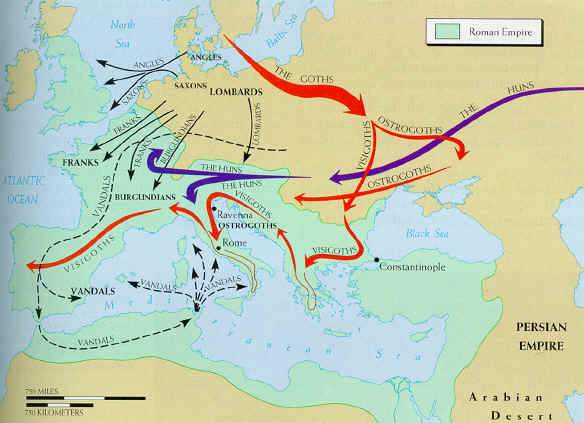
From Monetary to Barter Economy
States do not invariably proceed to greater economic prosperity: they can equally well recede from prosperity. Because so many parallels are drawn between our failing institutions of today and the end of the Roman Empire, parallels that can be over-simple if not clearly false, it is worth looking at matters in some detail.
Weakened by barbarian inroads, wars of succession, rampant inflation and a fading ethos of civic duty, the Roman Empire of the early 4th century was very different from the splendid entity founded by Augustus three and a half centuries earlier. Yet the concept survived. The military caesars of the late 3rd century dealt effectively with barbarian invasions, civil strife, economic disorder, and plague. Diocletion reformed the treasury, attempted to control prices and replaced the single emperor by a tetrarchy. Constantine introduced the solidus — a coin that was to last a thousand years — founded Constantinople in the east, and made Christianity the official religion of the later Roman Empire. {1}
Crispus
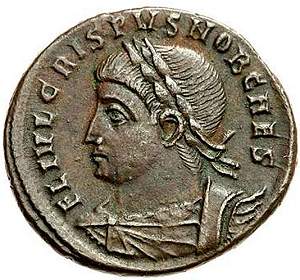 | Crispus was the eldest son of Constantine by Minervina, who was either a concubine or commoner first wife of the emperor. He was born some time between 295 and 305, and was executed on Constantine's orders in 326, possibly for an affair with Faustus, Constantine's official or second wife — who was herself executed shortly afterwards. {2} Imperial marriages in these troubled times were often made and unmade for dynastic reasons. |
| | Constantine's mother had been set aside when her husband sought an alliance with the emperor Maximian, for example, and in 307 Constantine himself allied with the Italian Augusti by marrying Fausta, the daughter of Maximian and sister of Maxentius. {2} |
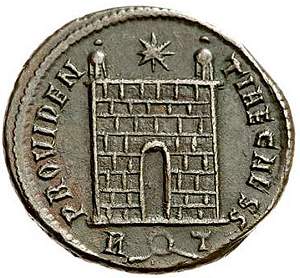 | Whatever the circumstances, Crispus was brought up properly, tutored by Lactantius, and soon proved himself a capable and loyal son. Together with his younger half-brother Constantine II and first cousin Licinius, he was named Caesar by the two Augusti in March 317. He married a young woman called Helena in 322, who bore him a son in October 322. Wife and son thereafter disappear from historical record, if only because all three suffered 'damnatio memoriae' — their names were deleted from official documents and monuments. {2} Yet, initially at least, Constantine had every reason to be proud of Crispus. The young man led victorius campaigns against the Franks and Alamanni in 318, 320 and 323. He joined his father in visiting Rome during 322, and was awarded an enthusiastic home-coming. {2} |
Reverse:PROVIDEN-TIAE CAESS, (Foresight of the Caesars) camp-gate with no doors and two turrets, star above; R (wreath)T. (RIC VII 288; LRBC 517) {2} | Crispus also joined his father's war with Licinius, and in his 324 naval victory at the battle of Hellepont proved himself an exceptional soldier and general. Crispus was assigned further legions, and won another important victory outside Chrysopolis. {2} |
The two victories helped Constantine encompass the final defeat of Licinius, which left the Empire with only one Augustus. Crispus was honoured by depictions on coins, statues, mosaics, cameos, etc. However extraordinary must seem the affair which ended Crispus' life and reputation, information comes from two independent sources, and seems the least unlikely of several possibilities. The entanglement with Faustus may have been real, or only alleged by a Faustus jealous of Crispus' successes, but Constantine certainly possessed a quick temper. In other respects he was an outstanding emperor, a brilliant general and energetic administrator, who stamped his character as no other on the later Roman state. {2}
Taxes, paid in coin, were levied throughout the empire, but proceeds went largely to Italy, and to the ever-important frontier armies. There were brief wars of succession, but second-century emperors mitigated the threat by adopting sons where necessary, and the immense task of administrating the later empire was divided between two Augusti and two Caesars. Septimus Severus (193-211) expanded the army to 400,000 soldiers against increasing barbarian threats, and improved its pay, but the cost was heavy taxes that fell increasingly on the less well-off. Nonetheless, the barbarians still broke through repeatedly in the third century, and disaster was only averted by a series of formidable military emperors. Diocletian (306-37) and Constantine the Great (306-37) then overhauled and reorganized the empire's administration, allowing German immigrants to settle within its borders. These Franks, Visigoths, Ostrogoths, Vandals, Burgundians and even Huns later enrolled in Roman armies and became outstanding soldiers. Constantine also embraced the Christian faith, which became the official state religion, a momentous event only briefly interrupted by Julian the Apostate's 361-3 reign. {3-9}
The empire was always one of great disparities in wealth and power, underpinned by slave labour and military repression, and along these fault lines the empire gradually came apart. The causes were various, both internal and external, and though probably not fatal individually, remorselessly combined into a final century and a half of calamity. The motives of the barbarian invasions was plunder, but they were also threatened by the Huns, who had broken into their realms around 370, destroying the Ostrogoth kingdom and driving 200,000 Visigoths across the Danube into the eastern empire. The emperor met the deluge at Adrianople in 378, and was overwhelmed: the cavalry fled, the soldiers were slaughtered and the emperor's own body was never recovered. {8-9}
Unity was essential in such perilous times, but rulers quarrelled with each other, and often with their own armies. The barbarians were bought off with treaties and subsidies, and, although allowed to settle extensively, were not assimilated. Rather than allow new blood to revitalize and defend Roman society, the barbarians were despised and heavily taxed. The outstanding generals of the period — Stilicho (359-408) and Aetius (396-454) — who could have stemmed the invasions — were eventually murdered by court intrigues. The Ostrogoths poured across France. The Visigoths invaded Italy. Rome was besieged for the third time in 410, and briefly occupied. The Huns, who had built a vast empire in the 430s stretching from Russia to the Baltic, invaded Gaul in 451. A major battle checked their progress, but they invaded Italy the following year, sacking Milan and other principal cities. The sudden death of Attila gave some respite, but the Vandal Gauseric landed at Ostia, sacked Rome, and carried off into captivity the widow of Valerian II and her two daughters. {8-9}
Ricimer (405-72) the imperial commander-in-chief gave some continuity of effort in following fifteen years, making and unmaking emperors, but the emperor Majorian's (457-61) offensive against Gaisseric in Cartagena ended disastrously. Help did not come from the eastern empire, and Spain was finally occupied by the Visigoths. When Orestes, formerly Attila's secretary, gave the imperial throne to his son Romulus Augustus, who was then deposed by Odoacer, the imperial commander of German troops in Italy, the Roman empire was clearly at an end. {8-9}
Each problem had added to others. Roman armies, often led by non-Italians and far from Rome, made and unmade emperors. In the 150 years preceding Constantine, nearly 80 generals were acclaimed emperor by their troops, indeed 30 alone between 247 and 270. The armies themselves, nominally large enough to deal with all barbarian threats, became progressively demoralized and ineffective, more a terror to the Roman provinces in which they were quartered than to the enemy. Gain and career advancement took the place of defending the fatherland, and troops commonly deserted at the first sign of trouble. Yet, however notional, armies had to be maintained, and the taxes for doing so fell largely on the rural poor, who increasingly abandoned their fields and took refuge with large landowners who could repel tax collectors and the military draft. Provincial governors converted the latter to gold. The rich and the free poor of Rome escaped taxation altogether, and Rome happily continued in its extravagant ways. Some 300,000 citizens were entitled to free bread in the fourth century, and 175 days in the year were given up to public festivals. The emperor was commonly not at Rome at all, but in provincial capitals, or increasingly at Ravenna when his safety was at risk. His contact with troops and the populace became more tenuous, being widened by elaborate protocols and layers of bureaucracy. {8-9}
Politics was a thankless and dangerous occupation, and the outstanding individuals, who had once joined the senatorial class, resided quietly in their estates or joined the Church. Imperial policies, which had alienated the rich and ruined the poor, were no kinder to the middle classes. The eastern empire enjoyed a generally honest and efficient administration — a reason for the long survival of Byzantium, plus its shorter and more easily defended borders — but officials in the west were compelled to extract taxes from their fellow citizens or suffer the same penalties: fines, imprisonment, flogging or execution. Legislation bound the rural poor to the land, and councillors likewise were not allowed to change their profession or travel abroad without special permission. {8-9}
The western Roman empire became a vast prison camp, but the oppression and regimentation of all but the rich only hastened its decay. Spies were everywhere, and 'All temperate and just liberty of speech was destroyed and everyone trembled at his own shadow.' {7} A burgeoning bureaucracy blunted orders and peculation prevented revenues from going where they were most needed. What coins there were — they grew progressively fewer and smaller — stoutly proclaimed victories and the benefits of the Roman state, but the claims were illusory. Emperors of the east and western empires did not cooperate, any more than did the Augusti with their Caesars. Stilicho, who had the opportunity several times of decisively defeating Alaric, preferred to divert him into attacking the eastern empire. Theodosius II required that a large slice of the western empire be added to his realms before he would recognize Valentinian. And when Marcian (450-57) was proclaimed eastern emperor, the west delayed acknowledgement, causing Marcian to withhold his subsidy to Attila in the hope of diverting that leader's attention to the west, which is what happened. The Catholic and Orthodox Churches increasingly fell out over doctrinal matters, and many churchmen opted out common life altogether, becoming priests and ascetics. The Christian faith itself, an obscure sect when made the official religion of Rome, and certainly no stranger to persecution, became increasingly intolerant, hunting down heresies and so further fracturing the social fabric. Roman education had always been narrow, serving public roles that were now largely nonexistent, but the many schools and universities scattered across the empire became more conventional still, prizing verbal skills in preference to anything practical or constructive. Augustine's Civitas Dei was not a political tract but a theological one, and many believers turned their thoughts from the corruption, squalor and repression around them to another and kinder world. {8-9}
Breakdown of Social Order
That the Roman Empire lasted so long, despite all the difficulties, is a tribute to an idea. However oppressive it became in the end — and many town and rural workers fled to large estates or even beyond its frontiers — Roman citizens realized that hardship with order was better than no order at all. The Roman silver/base metal coinage was crudely made in periods of the third century, and again at very end of the empire, but the gold issues, the aureus and the solidus, continued unchanged in their high standards of workmanship, and even the bronze issues, which diminished in size and frequency, were still intricately wrought, appearing jewel-like amid the steady break down in creature comforts, artistic standards and personal security. Until re-established as legal tender by the Byzantine nummus, the bronze coins became a talisman, a reminder of what life had been, and interpretation of social life needs to be seen through the historical record, as is always the case with coinage. Historians who praise the last Roman century as a necessary prelude to modern Europe, {10} or a shift to community-based societies, {11} should not count on Roman coinage for support. Life behind the resplendent symbolism seems to have been grim indeed.
Parallels with our Modern World
Rome was quite unlike our modern world, and George Orwell’s 1984 threatens to be our future far more than any militarised ‘plunder society’. The Roman Empire did not make territorial gains after Trajan’s conquests, moreover, though it did become more polarised, with taxation falling on the poorer classes. Several points are worth making.
The Roman world became increasingly divided between the ‘haves’ and ‘have nots’. Belief in the public ethos was gradually lost, and surveillance stepped up. But even in the early days of empire, under Augustus, astute commentators noted that while many things claimed by the Senate did not happen, many things happened without public knowledge. Lip service to Roman institutions was expected — which was why the Jews and the early Christian Church were persecuted. Whether the average citizen fully believed in the Roman pantheon of gods we cannot really know, but most acted as though they did because the gods were part of the social fabric that gave significance to their lives. So, most probably, is viewed market theory today by thinking citizens: the absurdities are evident enough, but it is a part too of our contemporary world, how we justify society and train our students to understand their place in work and leisure. It is one that is not easily replaced, since men will generally prefer order, stability and simplicity to the truth of matters, or even to individual freedom unless driven to extremes of injustice.
Left-leaning sociologists predicting the fall of the American empire have indeed employed such ethical arguments. Johan Galtung, {12} for example, believes that both the Roman Empire and western capitalist countries were and are inexorably driven by their ideologies to expand beyond their optimal functioning, leading to ceaseless wars abroad and civil unrest at home. When the cost of empire outweighs its benefits, the unresolved contradictions will compel the USA to relinquish its global hegemony, possibly by the 2020s. {13}
But ethical concerns are only one factor. {14} Though the Roman Empire was far less complex than our western societies, it took a combination of many factors working together for a long period to bring about decline and fall. America may very well lose its global pre-eminence to China and other countries, but a complete disintegration of American society seems unlikely. The other factors are far from comparable.
Michael Hudson and his colleagues have a less complacent view. Looking at how societies have historically handled debt, they contrast the west Asia societies that periodically annulled debt (the debt jubilees of the Sumerians, etc.) to those like Greece, Rome and western Europe that did not. Because creditors tend to default on loans, the sums owing (capital and interest) increase in an exponential fashion, leading to individuals, businesses and governments becoming subordinate to the financial institutions, which have today become the unseen but real power in the land. Debts inevitably increase faster than the economies can pay them off, and this simple observation provides an entirely new way of studying Greek and Roman history, where terms like tyrant, aristocrat and plebeians acquire novel but illuminating meanings. Tyrants, for example, were bad news for land-owning and creditor oligarchies but not for plebeians because tyrants had the power to cancel debts, redistribute land and hand over to new democracies. Without this cancellation, Roman societies indeed polarized into the increasingly rich and increasingly poor, suffered austerity policies, underwent revolts and wars and ultimately the collapse into serfdom and feudalism.
Greek Imperial Coinage

City states round the Mediterannean had struck their own coinage for centuries, often in base metal but occasionally silver and gold, and, though these diminished to a handful under Augustus, they were to expand again under later Roman rule to several hundred mints. The coins were commonly made in Rome, just as two millennia later the British mints turned out coinage for British colonies, but the coins were lively, local and individual. The reigning emperor, his wife or important member of his family generally appeared on the obverse, and some local scene or deity featured on the reverse. In the last is found much local history: the names of men of local importance — magistrates, priests and the like — and information on legends, festivals, statues and buildings that would otherwise be lost to us. {1} Moreover, though these coins are of variable workmanship, some as well struck as imperial issues, some rather rough and ready, they give us the flavour of local Roman life as it was until the coinage reforms of Diocletian in 294 AD largely swept away such local expressions. {19}
Types
Non-imperial coinages are commonly grouped into four types:
City coinages
Coinages of provincial leagues (koina)
‘Provincial issues’
Coinage of client kings
Most belong to the first catagory, were generally struck in bronze, and served as small change for local needs. But in the early empire days, under the Julio-Claudian emperors, civic bronze coins were also made in Spain, Gaul, Italy, Sardinia, Sicily, Africa Proconsularis, and Mauretania. Later, under the Antonines, civic coinage became a feature of the eastern empire only. Cities also struck issues to celebrate ‘alliances ’ with others cities.{20}
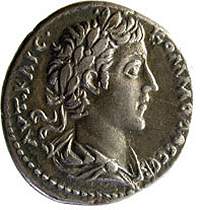 | Generally, we don't know why some cities were allowed to mint their own coinage, beyond recognizing that the practice awarded them polis status, i.e. some political and cultural independence within a frabric of shared symbolism. {21} Greek was the lingua franca of the eastern Roman world, as it would become in the Byzantine Empire, and these coins, otherwise so Roman looking, reconnected their users with the Hellenistic past. Affluent Romans sent their sons to study in Athens, of course, and the better-educated across the empire used Greek and Latin interchangeably. |
Greek Imperial Coinage: provincial issues. Marcus Aurelius and Commodus as co-emperors. Struck 177-80 at Antioch in Seleucis. 26 mm. 12.42 g. Obverse: aureate-headed bust of youthful Commodus wearing paludamentum. ΑΥΤ ΚΑΙС ΚοΜΜΟΔΟС СƐΒ around. | Output varied. Some cities produced very few coins, and only to mark a suitable occasion. Conversely, some of the larger cities struck coins almost continuously until the coinage reform of Diocletian. Particularly abundant were the coinages of Alexandria (Egypt), Caesaria (north-central Israel) and the cities of Moesia (Balkans) {19} |
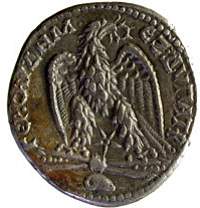 | Alexandria with Cleopatra's treasure and rich grain lands was the prize that fell to Augustus after Actium, and the province remained the private fief of the emperor. Its economy is reasonably well known through papyri finds, but is probably not representative of the empire as a whole. {22} The province used a low grade silver tetradrachm that paralleled the debasement of the Roman denarius, declining in weight and purity until the last issues were practically bare copper. {19} |
Reverse: eagle standing on thunderbolt, facing, and head turned right, with spreading wings, holding wreath in beak, star between legs, ram's head in exergue. ΓƐΡ СΑΡ ΔΗΜ ƐΞ Δ VΠΑΤ Β (Ξ shaped as Ζ) around. (McAlee (Commodus) 7) | Reverses depict Egyptian gods, animals and other scenes of interest, and commonly show the date according to the Alexandrian calendar. The Greek numeral or word follows the symbol 'L' for year. Also issued in base metal, but with an amazing variety in reverse types, were drachms and their fractions. {19} |
Variety
David Sear's {25} is the standard catalogue, but generally lists just the one coin of each city for each ruler. Many more exist, and these can often be acquired cheaply.{19}
Doug Smith on Ancioent Coin Forum provides an excellent introduction to the series. {2} The Roman Provincial Coinage Online project is in another realm altogether. At present it covers the periods AD 96–192, 238–244 (Asia only) and 249–254, but may include other periods in time. The database contains information on 24,475 coin types, based on 107,173 specimens, of which 19,263 have images. {20}
The economic aspects of Roman provinces is a vast area of specilized study, but the extensive bibliography provided by Christopher' Howegego's Ancient History from Coins would be an admirable place to start. {21} Serious students will probably need university library access.
In short, nothing shows the bustling vitality of Roman life better than its city coinages. Roman imperial coin issues are an enormous series, almost intimidating, with new pieces struck to commemorate important events appearing every few months. Within its smaller orbit, Greek imperial coinage is equally astounding, allowing the collector of modest means to build up a rewarding collection, and one where important discoveries can still be made. {19}
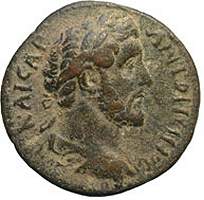 | 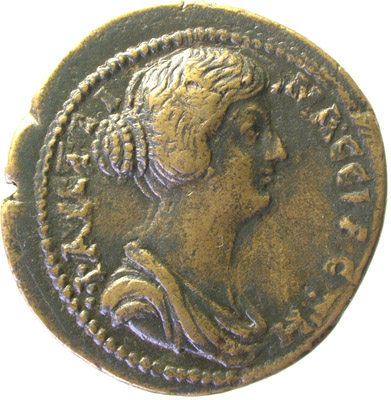 | 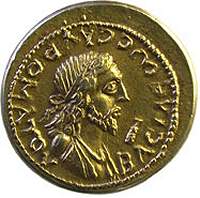 |
 | 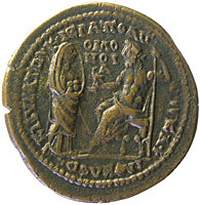 |  |
Greek Imperial Coinage: provincial league coinages. Ae Koinon of Macedonia. Antoninus Pius 27 mm. 11.95 g. Obverse: laureate-headed bust of Antoninus Pius wearing cuirass and paludamentum facing right. ΚΑΙСΑΡ ΑΝΤΩΝƐΙΝοС around. Reverse: thunderbolt with four wings. ΚΟΙΝΟΝ ΜΑΚƐΔΟΝΩΝ around and facing inward. (AMNG 261, BMC 155) | Greek Imperial Coinage: alliance coinages. Ae 37 25.86 g. City of Cybara in Phrygia. Faustina II (wife of Marcus Aurelius) c. 166-175, probably 172. Magistrate Kl. Philokles. Obverse: draped bust of Faustina facing right. ΦΑVСΤƐΙΝΑ СƐΒΑСΤΗ around. Reverse: left: veiled goddess standing facing right, having ? fruits in folds of dress: to right: Zeus seated facing left and holding eagle and long sceptre.ƐΠΙ ΚΛ ΦΙΛοΚΛΕΩС ΚΙΒVΡΑΤΩΝ Κ ΙƐΡΑΠοΛΙΤ(ΩΝ) ΟΜΟΝΟΙΑ around. (BMC 96, L. Weber, JIAN 14 (1912), 95, no. II) | Greek Imperial Coinage: client king coinages. Au aureus. 20 mm 7.66 g. Bosporan kingdom of northern Black Sea. Sauomates II (A.D. 180-192) Obverse:draped bust of Sauromates II wearing diadem and facing right. Club to right. ΒΑСΙΛƐωС СΑΥΡΟΜΑΤΟΥ around and facing outward. Reverse: laureate head of Commodus wearing paludamentum facing right. ƐΠV around. (Frolova, p. 171, pl. XXX.4-14) |
End of Empire
The Greek peninsular was incorporated into the Roman province of Macedonia after the Battle of Corinth in 146 BC, but territories and cities retained some independence. The revolt of Athens and other cities was crushed by Sulla in 88 BC, however, and the territories further devastated in the Roman Civil Wars. As throughout the Roman world, prosperity returned with Augustus, when Corinth became the capital of the province of Archaea, and Athens an important centre for learning, philosophy and the arts. {23-24}
Greek influence indeed came to permeate the entire Roman Empire, just as the Kin tartars and Mongols succumbed to the concepts of the higher civilisations they had conquered. Many Roman emperors developed an admiration for things Greek, and its language became a favorite of the educated elite in Rome. Roman poets developed Greek models. Roman architecture became a blend of Greek styles. Roman statuatry also emulated the Greek, though was generally more robust and realistic, lacking the brio, idealisation and sensitivity of Greek art at its best. And if Greek statues were hauled off to Italy to decorate the villas of the wealthy, the Romans also built temples, arches and markets in Greece itself. The Pax Romana was the longest period of peace that the squabbling Greek ever cities enjoyed, and the Romans made a genuine attempt to foster their well being and prosperity. {24} Roman rule was indeed a period of cross-fertilisation, when the Roman genius for law, order and social organisation was wedded to more etherial Greek considerations.
In the second and third centuries, Greece was divided into various provinces, each with some autonomy, and began to turn Christian under Constantine. Later came the depradations of the Goths and Vandals, but these tribal peoples were eventually driven off to found their own kingdoms in the western Roman Empire. In contrast, the east remained relatively prosperous and unified, and Greece grew into an economically important part of the eastern Roman and then Byzantine Empire. {24}
References and Further Reading
Need the 25 references and 7 illustration sources? Please consider the inexpensive ebook.
